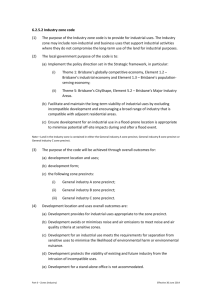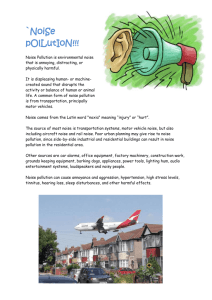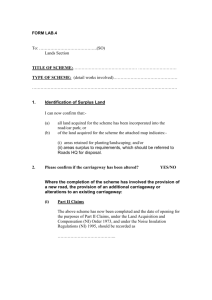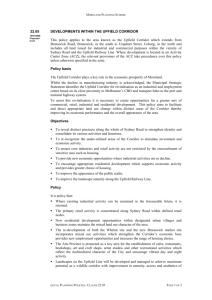Moreland Planning Scheme *** DELETE CL 43.02 S13 *** 22/10
advertisement
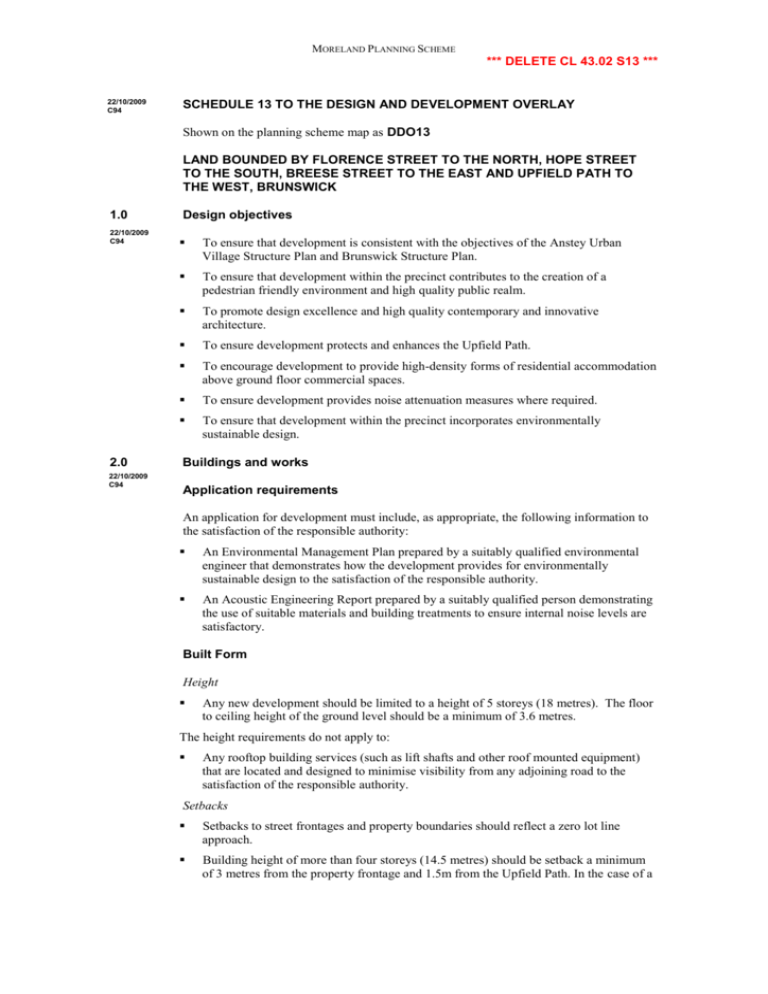
MORELAND PLANNING SCHEME *** DELETE CL 43.02 S13 *** 22/10/2009 C94 SCHEDULE 13 TO THE DESIGN AND DEVELOPMENT OVERLAY Shown on the planning scheme map as DDO13 LAND BOUNDED BY FLORENCE STREET TO THE NORTH, HOPE STREET TO THE SOUTH, BREESE STREET TO THE EAST AND UPFIELD PATH TO THE WEST, BRUNSWICK 1.0 22/10/2009 C94 2.0 22/10/2009 C94 Design objectives To ensure that development is consistent with the objectives of the Anstey Urban Village Structure Plan and Brunswick Structure Plan. To ensure that development within the precinct contributes to the creation of a pedestrian friendly environment and high quality public realm. To promote design excellence and high quality contemporary and innovative architecture. To ensure development protects and enhances the Upfield Path. To encourage development to provide high-density forms of residential accommodation above ground floor commercial spaces. To ensure development provides noise attenuation measures where required. To ensure that development within the precinct incorporates environmentally sustainable design. Buildings and works Application requirements An application for development must include, as appropriate, the following information to the satisfaction of the responsible authority: An Environmental Management Plan prepared by a suitably qualified environmental engineer that demonstrates how the development provides for environmentally sustainable design to the satisfaction of the responsible authority. An Acoustic Engineering Report prepared by a suitably qualified person demonstrating the use of suitable materials and building treatments to ensure internal noise levels are satisfactory. Built Form Height Any new development should be limited to a height of 5 storeys (18 metres). The floor to ceiling height of the ground level should be a minimum of 3.6 metres. The height requirements do not apply to: Any rooftop building services (such as lift shafts and other roof mounted equipment) that are located and designed to minimise visibility from any adjoining road to the satisfaction of the responsible authority. Setbacks Setbacks to street frontages and property boundaries should reflect a zero lot line approach. Building height of more than four storeys (14.5 metres) should be setback a minimum of 3 metres from the property frontage and 1.5m from the Upfield Path. In the case of a MORELAND PLANNING SCHEME *** DELETE CL 43.02 S13 *** corner site, building height of more than four storeys (14.5 metres) should be setback a minimum of 3m from both the primary and secondary frontage. Design and articulation New development should be appropriately articulated and modulated within the height and setback controls and provide visual interest through articulation, glazing and variation in materials and textures. Pedestrian access, movement and amenity The design and siting of development should provide for an improved environment for pedestrians and cyclists within the precinct and surrounding area (including the Upfield Path where appropriate) by: Ensuring pedestrian thoroughfares are well lit, provide clear lines of sight and avoid concealed spaces; Increasing the passive surveillance and perception of activity within the precinct through utilising active frontages at ground level; Relocating existing infrastructure underground as part of development of larger and/or consolidated sites; Providing a canopy for weather protection over the footpath; Providing high quality streetscape treatment (including street furniture and landscaping) along main pedestrian routes; Avoiding interruption of the footpath; Avoiding large areas of blank walls. Where unavoidable, large areas of blank walls must be treated with materials, artwork or in other ways that provide an attractive and visually interesting environment. Pedestrian entries to any development should be provided from main street frontages, via a lobby designed to: Be located close to the street frontage; Provide direct views into and out of the entrance lobby with no dead corners to ensure high levels of visibility and minimise concealment opportunities; Be easily identifiable. Car Parking and vehicle access Car parking areas should not dominate the streetscape or building design and should, where possible, be located in basements or to the rear of the site away from the street frontage. The design and siting of new development in the precinct should seek to increase movement permeability through the precinct and the surrounding area through the extension and potential widening of existing north-south laneways to: Allow direct connection of laneways from Hope St to Duckett Street and Duckett St to West Street; Provide improved opportunity for rear vehicle access to properties fronting Duckett Street, West Street, Florence Street and Breese Street. Noise attenuation Buildings and works must be sited and designed to incorporate appropriate noise attenuation measures to minimise railway noise levels or other external noise sources within a development to the satisfaction of the responsible authority. This may be achieved by: MORELAND PLANNING SCHEME *** DELETE CL 43.02 S13 *** Locating noise sensitive rooms and secluded private open space areas away from external noise sources. Providing adequate soundproofing where noise levels are expected to exceed ambient levels. Using noise resistant materials and construction methods, for example double glazing. Noise attenuation measures to external courtyard, balcony, recreation areas and other sensitive amenity areas should be implemented, where appropriate. Noise attenuation measures must be integrated with urban design objectives to achieve articulated, diverse facades and active frontages. Environmentally Sustainable Design Any development on the site must incorporate environmentally sustainable design measures in the areas of energy efficiency, natural ventilation, integrated water management, solar access, orientation, measures to reduce or manage car parking demand and encourage sustainable alternative transport modes, waste reduction/management and construction materials selection. 3.0 22/10/2009 C94 Decision guidelines Before deciding on an application, the responsible authority must consider, as appropriate: The design objectives of this schedule. The extent to which the development makes a positive contribution to the overall vitality of the Brunswick Major Activity Centre and Anstey Urban Village Precinct. The contribution the development makes to urban design, walkability, permeability and streetscape appearance of the area. The architectural quality and innovative design response of the building. Whether the development incorporates appropriate noise attenuation measures to minimise railway noise levels or other relevant external noise sources within the development having regard to the proposed use of the land. The layout and appearance of areas set aside for car parking, vehicular access, loading and unloading and the location of any proposed off street parking. The overall environmental sustainable performance of the development. The extent to which the proposed development achieves the design objectives set out in the Design Guidelines for Higher Density Residential Development published by the Department of Sustainability and Environment (2004). References Anstey Urban Village Structure Plan & Action Plan, David Mayes & Associates, Context Pty Ltd, Greg Tucker & Associates, June 2000. Moreland Industrial Land Use Strategy, Hansen Partnership, National Economics, August 2004. Design Guidelines for Development of Four or More Storeys, Moreland City Council, June 2005. Draft Brunswick Structure Plan 2008, Moreland City Council. Design Guidelines for Higher Density Residential Development, Department of Sustainability and Environment, 2004. Activity Centre Design Guidelines, Department of Sustainability and Environment, 2005.


